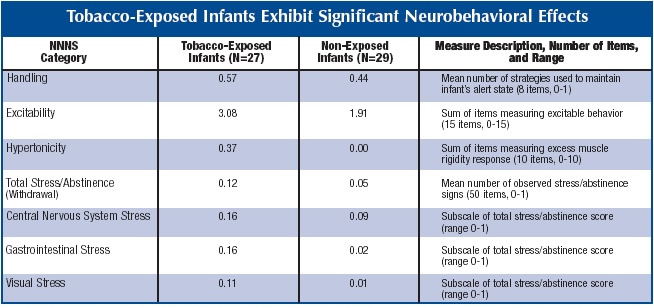The Neurobehavioral Legacy of Prenatal Tobacco Exposure
Download PDF Version What is PDF?
Jill Schlabig Williams
Jill Schlabig Williams is a Contributing Writer for NIDA NOTES.
Source: NIDA NOTES, Vol. 18, No. 6, February, 2004
Public Domain
Table of Contents (TOC)
Chapter 1: The Neurobehavioral Legacy of Prenatal Tobacco ExposureChapter 2: Cognitive Deficits Persist Into Early Adolescence for Children of Smoking Mothers
References
More than 17 percent of pregnant women between the ages of 15 and 44 smoke, according to the 2002 National Survey on Drug Use and Health. Much is known about the adverse effects of smoking during pregnancy: Cigarette smoke reduces blood flow through the placenta by as much as 38 percent, and pregnant smokers are more than twice as likely as nonsmokers to have an infant with low birthweight. New research by NIDA-funded investigators now provides the first evidence of toxic effects of prenatal exposure to tobacco smoke on newborn neurobehavior. This finding begins to fill in our picture of how the adverse neurological effects of prenatal exposure manifest from the earliest days of life to later observed effects, including lower IQ and increased risk of developing attention-deficit/hyperactivity disorder.
Drs. Barry M. Lester and Karen L. Law and their colleagues at Brown Medical School in Providence, Rhode Island, used the Neonatal Intensive Care Unit Network Neurobehavioral Scale (NNNS) to document the effects of maternal smoking on 1- to 2-day-old infants. The researchers found significant differences in short-term neurobehavioral status in tobacco-exposed newborns compared with unexposed newborns and noted that neurobehavioral impact worsened as the mothers’ smoking levels rose.
 "This study offers the first solid evidence of a dose-response
relationship between maternal smoking during pregnancy and
newborn neurobehavior," says Dr. Lester. "Babies born to
mothers who smoked while pregnant are stressed, which could
affect their development."
"This study offers the first solid evidence of a dose-response
relationship between maternal smoking during pregnancy and
newborn neurobehavior," says Dr. Lester. "Babies born to
mothers who smoked while pregnant are stressed, which could
affect their development."
"Focusing on newborn neurobehavioral outcomes is important," comments Dr. Vincent Smeriglio, Chair of NIDA’s Child and Adolescent Work Group. "It invites us to think about the continuity of consequences, as we see these very early behavioral differences in prenatally exposed children and consider them in light of effects in older children" (see below, "Cognitive Deficits Persist Into Early Adolescence for Children of Smoking Mothers"). "This research is providing an important piece of the puzzle linking prenatal exposure to cigarette smoke and long-term behavioral outcomes," Dr. Smeriglio says.
 The NICU Network Neurobehavioral Scale (NNNS), developed with NIDA funding to study prenatal drug exposure, was used to assess the
effects of prenatal nicotine exposure on 56 newborns within 48 hours of birth. Infants prenatally exposed to tobacco were highly aroused
and reactive, with more rigid muscles than non-exposed infants. Tobacco-exposed infants also scored higher on a checklist of 50 items that
serve as markers of stress or drug withdrawal in high-risk babies, with significant results evident for central nervous system, gastrointestinal,
and visual stress. Data shown are adjusted scores; statistical analyses controlled for parity, 5-minute Apgar score, and birthweight.
The NICU Network Neurobehavioral Scale (NNNS), developed with NIDA funding to study prenatal drug exposure, was used to assess the
effects of prenatal nicotine exposure on 56 newborns within 48 hours of birth. Infants prenatally exposed to tobacco were highly aroused
and reactive, with more rigid muscles than non-exposed infants. Tobacco-exposed infants also scored higher on a checklist of 50 items that
serve as markers of stress or drug withdrawal in high-risk babies, with significant results evident for central nervous system, gastrointestinal,
and visual stress. Data shown are adjusted scores; statistical analyses controlled for parity, 5-minute Apgar score, and birthweight.The researchers conducted their study with 56 new mothers, ages 18 to 35, and their newborns at a Providence hospital. Recruited shortly after they had given birth, the mothers--27 smokers and 29 nonsmokers--had not used any illegal drugs during their pregnancy and consumed fewer than four alcoholic drinks per month. Mothers who smoked reported smoking fewer than seven cigarettes per day, with tobacco use confirmed by measuring saliva levels of cotinine, the primary metabolite of nicotine. Only healthy newborns whose weights were appropriate to their gestational ages were included in the study; the researchers controlled for birthweight so the effects they found on neurobehavior could not be attributed to the effects of maternal smoking on birthweight.
A certified examiner who was unaware of the mother’s smoking status administered the NNNS to each newborn within 48 hours of birth. The test examines an infant’s neurological state, considering muscle tone, reflexes, and integrity of the central nervous system (CNS); behavior, including attention, arousal, and excitability; and a checklist of 50 items shown by previous research to be markers of stress or--in high-risk babies--of drug withdrawal. Dose-response effects were determined by evaluating the relationship between measures of maternal smoking (cotinine and self-report) and NNNS scores.
 "Infants exposed to tobacco in the womb showed statistically
significant differences that suggest toxic effects of prenatal
tobacco exposure on the newborn neurological system," says
Dr. Lester. The tobacco-exposed infants were highly aroused
and reactive as indicated by the higher excitability and
handling scores, and their muscles were more rigid. They
also showed signs of stress and drug withdrawal consistent
with what has been reported in infants exposed to other
drugs. When the total stress/abstinence scores were broken
down into subscales, exposed infants showed significant
CNS, gastrointestinal, and visual effects. Further, infants
prenatally exposed to tobacco required more handling to
keep them in a quiet and alert state.
"Infants exposed to tobacco in the womb showed statistically
significant differences that suggest toxic effects of prenatal
tobacco exposure on the newborn neurological system," says
Dr. Lester. The tobacco-exposed infants were highly aroused
and reactive as indicated by the higher excitability and
handling scores, and their muscles were more rigid. They
also showed signs of stress and drug withdrawal consistent
with what has been reported in infants exposed to other
drugs. When the total stress/abstinence scores were broken
down into subscales, exposed infants showed significant
CNS, gastrointestinal, and visual effects. Further, infants
prenatally exposed to tobacco required more handling to
keep them in a quiet and alert state.
"These infants’ higher scores in such areas as excitability and arousal reflect that nicotine is a stimulant," says Dr. Lester. The researchers also found consistent dose-response relationships for both the cotinine bioassay results and the self-reports of number of cigarettes smoked per day. "These results indicate that greater exposure to tobacco smoke is related to increasingly negative neurobehavioral effects," he adds, "and that these children may be at increased risk for future neurobehavioral problems."
Dr. Lester is currently designing a larger, multisite study focusing on the neurobehavioral effects of prenatal exposure to cigarette smoke. Future research will attempt to pinpoint which components of tobacco are responsible for the known neuro-behavioral effects; determine whether those effects are long-term; clarify whether newborns experience nicotine withdrawal; and separate the effects of prenatal exposure from those of postnatal exposure through second-hand smoke or breastfeeding.
With valid information on the potential neurobehavioral effects of prenatal tobacco exposure, more pregnant women may be swayed to quit smoking, notes Dr. Lester. "The smoking effects observed in our study underscore the importance of smoking cessation programs, particularly for women of childbearing age," he says.
Cognitive Deficits Persist Into Early Adolescence for Children of Smoking Mothers
Teenage children of mothers who smoked during pregnancy perform more poorly on tests of general intelligence and on tasks requiring auditory memory than do children who were not exposed to cigarette smoke before birth, according to NIDA-supported researchers at Carleton University in Ottawa, Canada. Dr. Peter Fried and his colleagues, who have followed the development of children born to smoking mothers as part of the Ottawa Prenatal Prospective Study, previously reported poorer cognitive abilities in children of smokers when the children were ages 5 to 6 and 9 to 12. "The results we see now that the children are 13- to 16-year-olds continue to suggest that exposure to cigarettes before birth has negative impact on general IQ and on auditory memory. And the effects are dose-related: The deficits are more severe in children of heavy smokers," Dr. Fried says.
 The scientists administered a battery of tests to 145 13- to 16-year-olds
(78 boys, 67 girls) whose mothers smoked heavily (more than a pack
per day), lightly (less than a pack per day), or not at all during
their pregnancies. The tests included measures of general achievement
(reading and language skills), visual memory (identifying a missing
number from a random sequence of numbers from 1 to 10), auditory memory
(repeating tape-recorded sentences of increasing length and complexity),
and general intelligence (IQ scores). In some tests there were no
significant differences among the children. In tests of general intelligence
and auditory memory, however, children born to smokers had lower scores
than did children of nonsmokers, and children born to heavy smokers
had poorer scores than children of light smokers. For example, in
the general intelligence test, for which scores from 99 to 109 are
considered "normal," children of nonsmokers had an average score of
113.4; of light smokers, 109.8; and of heavy smokers, 105.2.
The scientists administered a battery of tests to 145 13- to 16-year-olds
(78 boys, 67 girls) whose mothers smoked heavily (more than a pack
per day), lightly (less than a pack per day), or not at all during
their pregnancies. The tests included measures of general achievement
(reading and language skills), visual memory (identifying a missing
number from a random sequence of numbers from 1 to 10), auditory memory
(repeating tape-recorded sentences of increasing length and complexity),
and general intelligence (IQ scores). In some tests there were no
significant differences among the children. In tests of general intelligence
and auditory memory, however, children born to smokers had lower scores
than did children of nonsmokers, and children born to heavy smokers
had poorer scores than children of light smokers. For example, in
the general intelligence test, for which scores from 99 to 109 are
considered "normal," children of nonsmokers had an average score of
113.4; of light smokers, 109.8; and of heavy smokers, 105.2.
In some areas of cognitive function, the gap in test results between exposed and unexposed children has narrowed as the children have grown, observes Dr. Fried. This improvement is most notable in tests that measure achievement rather than innate ability. For instance, although measured IQ remains lower for exposed children, their scores on reading and language skills are equivalent to those of unexposed children. "This comparative improvement in achievement is associated most strongly with the educational level of the parents. Achievement tests are in many ways a measure of formal learning acquired at home and in school. It appears that family and environmental factors that support learning can help moderate the negative effects seen in measures of ability," Dr. Fried explains.
"The improvements found in this most recent evaluation of these children are encouraging," says Dr. Vincent Smeriglio, chair of NIDA’s Child and Adolescent Work Group. "Nonetheless, the continued finding of poorer performance as the exposed children enter adolescence underscores the damage that appears to be done by smoking during pregnancy. These kids may be catching up in some ways, but they started out with a serious disadvantage."
Source
Fried, P.A.; Watkinson, B.; Gray, R. Differential effects on cognitive functioning in 13- to 16-year-olds prenatally exposed to cigarettes and marihuana. Neurotoxicology and Teratolgy 25(4):427-436, 2003.
Law, K.L.; Stroud, L.R.; LaGasse, L.L.; Niaura, R.; Liu, J.; Lester, B. Smoking during pregnancy and newborn neurobehavior. Pediatrics 111(6):1318-1323, 2003.


